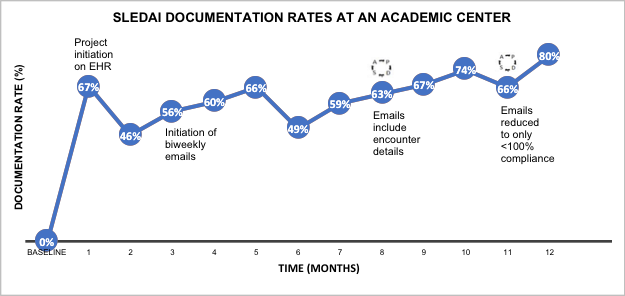Session Information
Session Type: ACR Poster Session A
Session Time: 9:00AM-11:00AM
Background/Purpose: The 2008 European League Against Rheumatism (EULAR) Task Force on SLE management encourages the use of at least one of the SLE disease indices for the monitoring of disease activity. SLEDAI documentation is crucial to obtain for purposes of clinically meaningful translational and basic science research. This study aimed to 1) identify baseline SLEDAI documentation rates in an academic setting 2) determine if biweekly email feedback would improve documentation rates and 3) ascertain perceived barriers to documentation.
Methods: Chart review of all SLE encounters over a one-month period was performed at an academic center to ascertain a baseline SLEDAI documentation rate. Physicians were then instructed to document SLEDAI scores into a designated section of the electronic health record (EHR) at month 1. Chart review was repeated continuously for each provider over the next 12 months. Personalized SLEDAI documentation rates were emailed to each provider biweekly. Two Plan-Do-Study-Act (PDSA) cycles were performed over the 12-month period. Physicians completed a survey regarding documentation barriers at the close of the study.
Results: 704 SLE encounters were reviewed for this study. Pre-intervention, baseline SLEDAI documentation rates were 0%. Following the introduction of a designated section for documentation within the EHR, rates increased to 67%. After the initiation of personalized biweekly emails, collective documentation rates increased to 80% by 12 months. Rates continued to increase after emails included encounter details (PDSA 1), and after email frequency was reduced to contact only those providers who did not meet 100% compliance (PDSA 2). Fellows (77%) had higher documentation rates compared to attending physicians (58%) throughout the study. Survey results revealed that the majority of physicians (65%) believed SLEDAI documentation improved patient care, though 40% of physicians cited such documentation as a burden. Major barriers to documentation were cited to be forgetfulness and lack of time.
Conclusion: This quality improvement study demonstrates that a biweekly email feedback intervention increased SLEDAI documentation rates at an academic center, with higher documentation rates seen with rheumatology fellows. Additionally, physicians did perceive that increased documentation directly improved patient care. Major barriers to documentation were reported to be forgetfulness and lack of time.
To cite this abstract in AMA style:
Chung SH, Juo HH, Thomason J, Bays A. Implementation of Systemic Lupus Erythematosus Disease Activity Index (SLEDAI) Documentation in Systemic Lupus Erythematosus (SLE) Patients at an Academic Medical Center [abstract]. Arthritis Rheumatol. 2018; 70 (suppl 9). https://acrabstracts.org/abstract/implementation-of-systemic-lupus-erythematosus-disease-activity-index-sledai-documentation-in-systemic-lupus-erythematosus-sle-patients-at-an-academic-medical-center/. Accessed .« Back to 2018 ACR/ARHP Annual Meeting
ACR Meeting Abstracts - https://acrabstracts.org/abstract/implementation-of-systemic-lupus-erythematosus-disease-activity-index-sledai-documentation-in-systemic-lupus-erythematosus-sle-patients-at-an-academic-medical-center/


